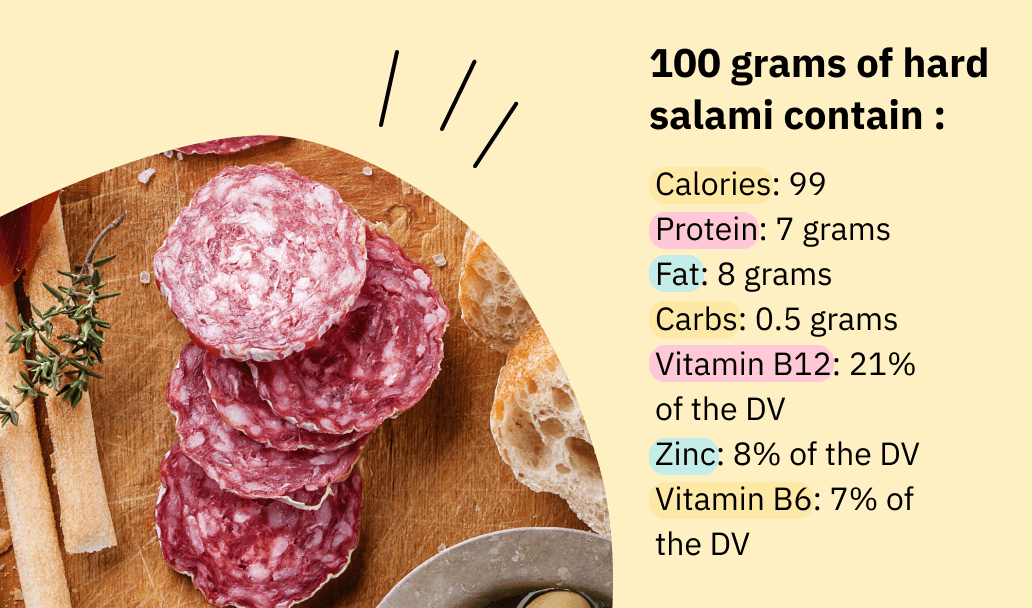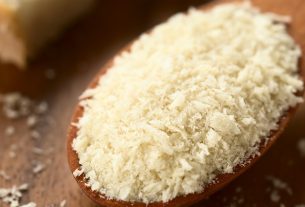Can a delicious cured meat also be healthy?
That’s the question many people ask when it comes to salami.
Packed with protein, fats, and a burst of savory flavors, salami holds a special place on charcuterie boards and in sandwiches.
But before sinking your teeth into this culinary delight, let’s dive deeper into the topic and examine whether salami can truly be a healthy indulgence.
Is salami really as guilt-free as it appears, or should we exercise caution?
Let’s find out.
is salami healthy
Salami can be enjoyed in moderation as part of a well-rounded diet.
It is low in carbs and calories but high in protein, fat, and sodium.
It is a good source of vitamins and minerals such as vitamin B12, thiamine, niacin, and zinc.
Additionally, some types of salami may contain probiotics, which can support digestion, immunity, and heart health.
However, it is important to note that salami is high in sodium, which can increase water retention and blood pressure levels.
Furthermore, salami is considered a type of processed meat, which has been linked to an increased risk of certain types of cancer.
It is also susceptible to contamination with harmful pathogens.
To ensure safety, it is recommended to heat salami to an internal temperature of 165°F (74°C) before consuming.
It is advised to choose a brand that is low in sodium and practice proper food storage and hygiene when preparing and consuming salami.
Key Points:
- Salami can be enjoyed in moderation as part of a well-rounded diet.
- Salami is low in carbs and calories, but high in protein, fat, and sodium.
- Salami is a good source of vitamins and minerals such as vitamin B12, thiamine, niacin, and zinc.
- Some types of salami may contain probiotics, which can support digestion, immunity, and heart health.
- However, salami is high in sodium, which can increase water retention and blood pressure levels.
- Salami is considered a type of processed meat, which has been linked to an increased risk of certain types of cancer and can be contaminated with harmful pathogens.
is salami healthy – Watch Video
💡
Pro Tips:
1. Salami was originally created as a way to preserve meat, making it a popular choice for people living in regions with limited access to refrigeration.
2. Salami is typically made from a mix of ground pork, beef, or veal, and can sometimes include additional spices like garlic, black pepper, and fennel seeds.
3. While salami can be high in fat, it also contains several essential nutrients such as protein, iron, and vitamin B12. However, consuming it in moderation is recommended due to its high sodium content.
4. Contrary to popular belief, salami is not technically considered a raw meat product. It undergoes a curing and fermenting process which helps preserve it and develop its unique flavors.
5. Salami originated in Italy and has been a staple of Italian cuisine for centuries. It gained popularity across Europe during the Middle Ages and eventually immigrated to different parts of the world through Italian diaspora.
Salami: A Nutrient Breakdown
Salami, a type of cured sausage typically made from pork or beef, is a popular choice for charcuterie boards and sandwiches. But is it healthy? Let’s take a closer look at the nutrient breakdown of salami to determine its health benefits.
Salami is low in carbohydrates and calories, making it a suitable option for those following a low-carb or calorie-restricted diet. Three slices of hard salami contain just 99 calories, along with 7 grams of protein, 8 grams of fat, and only 0.5 grams of carbohydrates. This high protein content can contribute to a feeling of fullness and aid in muscle growth and repair.
In addition to its macronutrient profile, salami is also a good source of essential vitamins and minerals. It contains vitamin B12, thiamine, niacin, and zinc. Vitamin B12 and niacin are important for brain function, while zinc plays a crucial role in DNA synthesis, wound healing, and immune health.
- Salami is low in carbohydrates and calories.
- Three slices of hard salami contain just 99 calories, 7 grams of protein, 8 grams of fat, and 0.5 grams of carbohydrates.
- Salami is a good source of essential vitamins and minerals.
- It contains vitamin B12, thiamine, niacin, and zinc.
- Vitamin B12 and niacin are important for brain function.
- Zinc plays a crucial role in DNA synthesis, wound healing, and immune health.
Salami is a versatile food that can be enjoyed in moderation as part of a balanced diet.
The Pros And Cons Of Salami Nutrition
While salami offers certain health benefits, it is important to consider its downsides as well. One of the main concerns with salami is its high sodium content. Just three slices of salami can provide nearly a quarter of the daily recommended sodium intake. Consuming high amounts of sodium can lead to water retention and elevated blood pressure levels, which may increase the risk of cardiovascular diseases.
Another drawback of salami is its categorization as processed meat. Processed meats have been linked to an increased risk of several types of cancer. They often contain preservatives like sodium nitrate, which can be converted into a compound called nitrosamine in the body. Nitrosamines have been associated with a higher risk of certain types of cancer.
Moreover, salami and other meat products can be susceptible to contamination with harmful pathogens, including Salmonella, Escherichia coli (E. coli), and Listeria monocytogenes. This risk can be mitigated by proper food storage and hygiene practices. Heating salami to an internal temperature of 165°F (74°C) is recommended to ensure safety.
Salami’s Impact On Sodium Intake
It’s worth noting that salami is notably high in sodium. In fact, some varieties can pack as much as 535 mg of sodium into just a 3-slice serving. Considering that the American Heart Association recommends limiting sodium intake to less than 2,300 mg per day, or ideally less than 1,500 mg daily, it is crucial to be mindful of salami’s contribution to your sodium intake.
High sodium diets have been associated with an increased risk of stomach cancer. Therefore, individuals who are concerned about their sodium intake should seek out low-sodium brands or limit their consumption of salami altogether.
Salami And The Importance Of Brain Function
Salami is a food that offers important nutrients for brain function. Vitamin B12 and niacin, which are both present in salami, play vital roles in maintaining the health of the brain. Vitamin B12 contributes to the synthesis of neurotransmitters and the upkeep of nerve cells. On the other hand, niacin assists in improving brain function and cognitive performance. By incorporating salami into a balanced diet, you can enhance the overall well-being of your brain.
To summarize:
- Salami contains Vitamin B12 and niacin that are crucial for brain health.
- Vitamin B12 is involved in neurotransmitter synthesis and nerve cell maintenance.
- Niacin helps improve brain function and cognitive performance.
Salami As A Source Of Probiotics
Some types of salami may contain probiotics, which are beneficial bacteria that support digestion, immunity, and heart health. These probiotics can improve the balance of gut bacteria and enhance overall gut health.
However, not all salami brands contain probiotics, so it is important to:
- Read product labels
- Choose specific salami varieties known to contain live bacteria cultures.
By doing so, you can ensure you are consuming salami that provides the potential health benefits associated with probiotics.
“Not all salami brands contain probiotics, so it is important to read product labels or choose specific salami varieties known to contain live bacteria cultures.”
The Link Between Salami And High Blood Pressure
Due to its high sodium content, regular consumption of salami can contribute to high blood pressure levels. Sodium plays a significant role in regulating blood pressure. When sodium intake is excessive, it can lead to an imbalance in fluid levels and increase the volume of blood in the arteries. This, in turn, raises blood pressure, increasing the risk of cardiovascular diseases.
To minimize the impact on blood pressure, it is recommended to limit the consumption of high-sodium foods like salami and opt for lower sodium alternatives whenever possible.
- Regular consumption of salami can contribute to high blood pressure levels
- Sodium plays a significant role in regulating blood pressure.
- Excessive sodium intake can lead to imbalances in fluid levels and increased blood volume in the arteries.
- This raises blood pressure and increases the risk of cardiovascular diseases.
“To minimize the impact on blood pressure, it is recommended to limit the consumption of high-sodium foods like salami and opt for lower sodium alternatives whenever possible.”
The Connection Between Salami And Stomach Cancer
In addition to its effect on blood pressure, high sodium diets have been associated with an increased risk of stomach cancer. Consuming processed meats, including salami, has been linked to a higher incidence of this type of cancer. The International Agency for Research on Cancer classifies processed meat as carcinogenic, meaning it has the potential to cause cancer.
As with any food, moderation is key. Enjoying processed meats like salami in moderation as part of a well-rounded diet is acceptable, but it is advisable to limit consumption to reduce the risk.
Processed Meats And The Risk Of Cancer
The classification of processed meat as carcinogenic raises concerns about its impact on overall cancer risk. Processed meats, including salami, often undergo curing processes that involve adding preservatives like sodium nitrite. The presence of sodium nitrite in these products can lead to the formation of nitrosamines, which are known to increase the risk of certain cancers.
To minimize the potential risk, individuals should consider opting for uncured salami or selecting brands that use natural additives instead of chemical preservatives.
Salami And The Potential For Foodborne Illness
Salami and other meat products can be contaminated with harmful pathogens such as Salmonella, Escherichia coli (E. coli), and Listeria monocytogenes, leading to foodborne illnesses with symptoms like nausea, vomiting, diarrhea, and stomach pain.
To ensure the safety of consuming salami, it is important to:
- Practice proper food storage and hygiene.
- Heat salami to an internal temperature of 165°F (74°C) to effectively eliminate any potential harmful bacteria.
“Proper handling and cooking of salami is crucial in preventing foodborne illnesses.”
Making Smart Choices With Salami: Tips For Enjoying Safely
While salami can be enjoyed in moderation, it is essential to make smart choices to minimize its potential risks. Here are some tips for enjoying salami safely:
-
Choose low-sodium brands: Opt for salami varieties that are lower in sodium to reduce your overall sodium intake.
-
Heat to an internal temperature of 165°F (74°C): Heating salami to this temperature will help eliminate any harmful bacteria and ensure its safety.
-
Consider uncured salami or natural additives: Uncured salami uses salt and natural additives instead of chemical preservatives. It may be a healthier alternative for those concerned about the potential risks associated with sodium nitrite.
-
Practice proper food storage and hygiene: Store salami at the appropriate temperature and follow food safety guidelines to reduce the risk of contamination and foodborne illness.
In conclusion, salami offers certain health benefits as a source of protein, vitamins, and minerals. However, its high sodium content, association with processed meats, and potential for contamination with harmful pathogens should be considered. By enjoying salami in moderation and making informed choices, individuals can still enjoy this cured sausage as part of a well-rounded diet.
- Choose low-sodium brands
- Heat to an internal temperature of 165°F (74°C)
- Consider uncured salami or natural additives
- Practice proper food storage and hygiene
💡
You may need to know these questions about is salami healthy
What is unhealthy about salami?
One of the main unhealthy aspects of salami lies in its composition, specifically in the high amounts of saturated fat and sodium it contains. Saturated fat can lead to an increase in cholesterol levels and contribute to the risk of heart disease. Additionally, excessive sodium intake can lead to high blood pressure and other cardiovascular issues. Another concern with salami is its tendency to cause water retention, which can put strain on the liver and body’s detoxification processes. Overall, while salami may be a flavorful treat, its high saturated fat and sodium content make it an unhealthy choice for regular consumption.
Is salami good for you to eat?
Salami, a type of salumi, can be enjoyed as part of a balanced diet due to its notable protein content. Proteins are essential for the body as they support muscle and bone development, aid in weight management, boost the immune system, and facilitate efficient messaging between the brain and body. While salami’s protein-rich nature offers these potential benefits, moderation is key as it is also high in unhealthy saturated fats and sodium. Thus, incorporating limited amounts of salami alongside other nutritious foods can contribute to a well-rounded and enjoyable diet.
Is salami the healthiest lunch meat?
While salami certainly has its unique taste and appeal, it may not hold the title of the healthiest lunch meat. According to Crumble Smith, healthier options include turkey, chicken, or roast beef. Unlike salami, these alternatives tend to be lower in sodium and undergo less processing. Salami, bologna, pepperoni, and pastrami, on the other hand, are often associated with higher sodium content and a more heavily processed nature. Ultimately, making mindful choices about deli meats can contribute to a healthier lunchtime experience.
What kind of salami is the healthiest?
When considering the healthiest salami option, it depends on what nutrients you prioritize. If you are looking for a salami that provides a good amount of B vitamins for energy production, Genoa salami would be the better choice. It contains approximately 20 percent of the daily value of B vitamins. However, if you are more concerned about protein intake, hard salami might be the healthier option, as it offers a higher percentage of your daily protein value along with slightly higher potassium and sodium content. Ultimately, the healthiest salami for you depends on your specific nutritional needs and objectives.
Reference source
https://www.healthline.com/nutrition/is-salami-healthy
https://salumipasini.com/en/is-salami-good-for-weight-loss/
https://www.angelsalumi.com/blogs/angels-blog/8-reasons-why-salami-makes-a-healthy-snack
https://www.usatoday.com/story/life/food-dining/2023/06/04/what-is-the-healthiest-deli-meat/70262551007/



